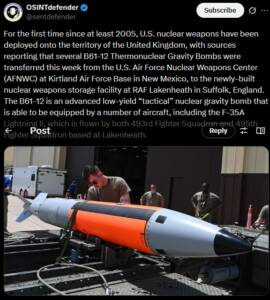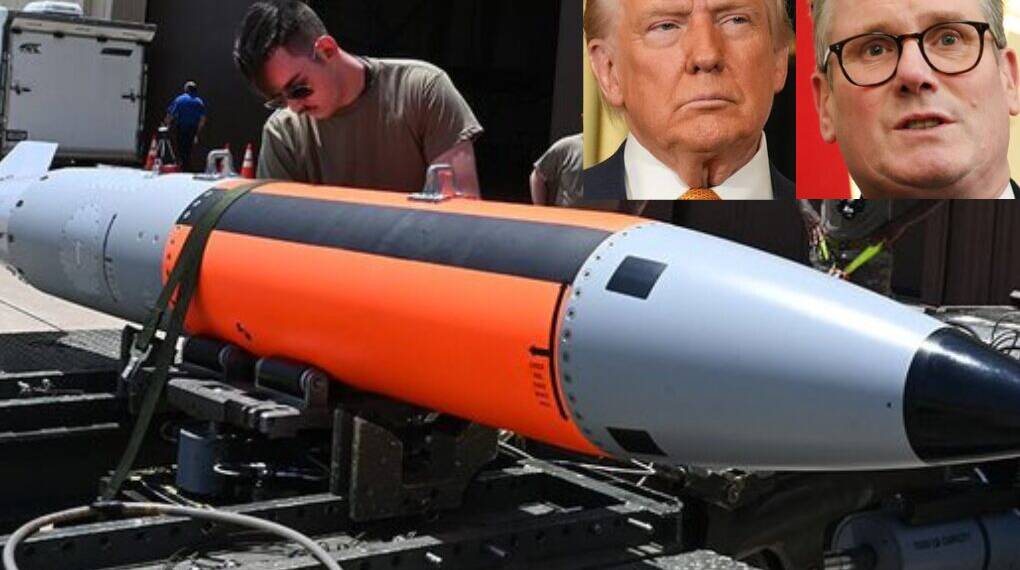In a development that has rattled security analysts, reignited debates over sovereignty, and drawn sharp criticism from peace activists, the United States has reportedly deployed B61-12 tactical nuclear bombs to RAF Lakenheath in the United Kingdom—for the first time in 17 years.
This move, quietly carried out earlier this month, marks a profound shift in NATO’s nuclear posture and could have far-reaching implications for global stability, UK sovereignty, and the future of deterrence diplomacy.
A Return to Cold War Posture
According to multiple reports, the B61-12 bombs—a modernized, low-yield, precision-guided thermonuclear weapon—were flown from the U.S. Air Force Nuclear Weapons Center at Kirtland Air Force Base in New Mexico to a newly constructed storage facility at RAF Lakenheath, Suffolk.
These weapons are believed to support the U.S. F-35A fighter jets stationed there under the 48th Fighter Wing.
This is the first time since 2008 that the UK has hosted U.S. nuclear weapons on its soil. The 2008 withdrawal marked the end of over five decades of U.S. nuclear deployment in Britain, a holdover from the Cold War era when the UK was a key nuclear hub in Europe.

Why Now?
The redeployment of nuclear weapons comes amid intensifying tensions with Russia, NATO’s bolstered military preparedness, and deteriorating global arms control efforts. It also follows President Trump’s 50-day ultimatum to Vladimir Putin to end the war in Ukraine—an ultimatum that Russia has ignored while escalating attacks on civilian areas.
The UK, for its part, recently confirmed the purchase of 12 F-35A fighter jets, signaling a renewed role for the Royal Air Force in NATO’s dual-capable aircraft nuclear sharing program. Prime Minister Sir Keir Starmer has backed the move, stating:
“In an era of radical uncertainty, we can no longer take peace for granted.”
What is the B61-12?
The B61-12 is a variable-yield tactical nuclear bomb weighing around 320 kilograms, with explosive potential up to 50 kilotons—more than twice the power of the “Fat Man” bomb dropped on Nagasaki. Designed to be carried by modern stealth aircraft, including the F-35A Lightning II, the B61-12 is meant to offer precision, flexible nuclear response with reduced collateral damage.
Its deployment is part of the U.S. effort to modernize its nuclear arsenal and reinforce NATO’s deterrent in the face of Russian aggression. But with that modernization comes a wave of ethical, legal, and political concerns.
A Question of Sovereignty
While the UK is a nuclear-armed state in its own right—maintaining a fleet of Vanguard-class submarines carrying Trident missiles—it has not hosted U.S. nuclear weapons in nearly two decades. Now, with foreign nuclear arms back on British soil, serious questions are emerging:
How much control does the UK have over U.S. nuclear weapons stationed here?
Can Britain veto their use?
What does this mean for the UK’s sovereignty and its obligations under international law?
Opposition politicians and activists argue that allowing a foreign power to deploy nuclear weapons within the UK—without transparent parliamentary oversight—undermines democratic accountability.
Public and Political Backlash
Protests have already begun outside RAF Lakenheath, with demonstrators holding banners reading “No More Nukes” and “We Didn’t Vote for This.” Peace groups and local councillors argue that the UK is being dragged into an escalated nuclear confrontation without public consent.
Transparency and anti-nuclear groups such as CND (Campaign for Nuclear Disarmament) and ICAN UK have called for full disclosure from the UK Ministry of Defence (MoD), which has so far refused to confirm or deny the presence of nuclear weapons, citing national security.
Strategic Deterrence or Dangerous Escalation?
Supporters of the move within NATO argue that reintroducing tactical nuclear weapons in Europe is a vital response to Russia’s increasing hostility and nuclear brinkmanship. They say it strengthens deterrence, reassures allies, and shows readiness.
Critics, however, warn that this could destabilize the strategic balance, especially if Russia sees the deployment as justification for its escalatory steps—like forward-positioning nuclear-capable systems or even withdrawing from remaining arms control treaties.
Russia, which has long criticized NATO’s expansion and nuclear deployments, is likely to retaliate rhetorically and militarily, potentially including counter-deployments in Kaliningrad or near Finland’s border.
The Bigger Picture: NATO vs Russia, Again
The deployment highlights a larger transformation in global military dynamics. NATO is increasingly rearming and repositioning for long-term confrontation with Russia. Space, cyber, and now tactical nuclear weapons are back on the table.
Meanwhile, Russia’s invasion of Ukraine and its nuclear threats have undone years of progress in nuclear disarmament and diplomacy. The fragile post-Cold War security architecture is collapsing, replaced by a new era of great power rivalry—now armed with more flexible, precise, and deployable nuclear options.
A Historic Shift with Global Implications
With U.S. B61 nuclear bombs returning to UK soil, NATO appears to be signaling that the post-Cold War dream of denuclearization is over. Deterrence, not disarmament, is once again the guiding doctrine.
But with that shift comes the risk of accident, miscalculation, or escalation. And once nuclear weapons are back in motion, no one knows exactly where the line is.
Whether this move strengthens peace or moves us closer to World War III, only time will tell.








